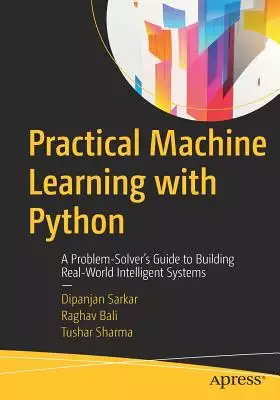Coursera Model Think的問題,透過圖書和論文來找解法和答案更準確安心。 我們找到下列懶人包和總整理
Coursera Model Think的問題,我們搜遍了碩博士論文和台灣出版的書籍,推薦Sarkar, Dipanjan/ Bali, Raghav/ Sharma, Tushar寫的 Practical Machine Learning With Python: A Problem-solver’s Guide to Building Real-world Intelligent Systems 可以從中找到所需的評價。
國立臺灣科技大學 財務金融研究所 陳俊男所指導 陳志娟的 當矽谷遇上華爾街–好好投資幫您做好投資 (2019),提出Coursera Model Think關鍵因素是什麼,來自於金融科技、顧客旅程地圖、定價理論、訂閱制、價值共創。
而第二篇論文國立雲林科技大學 數位媒體設計系 楊晰勛所指導 楊鈞淳的 直播輔助課程於磨課師 2D 動畫教學之應用與實踐 (2018),提出因為有 直播、磨課師、課程設計、課程互動、2D 動畫、遠距教學的重點而找出了 Coursera Model Think的解答。
Practical Machine Learning With Python: A Problem-solver’s Guide to Building Real-world Intelligent Systems

為了解決Coursera Model Think 的問題,作者Sarkar, Dipanjan/ Bali, Raghav/ Sharma, Tushar 這樣論述:
Master the essential skills needed to recognize and solve complex problems with machine learning and deep learning. Using real-world examples that leverage the popular Python machine learning ecosystem, this book is your perfect companion for learning the art and science of machine learning to becom
e a successful practitioner. The concepts, techniques, tools, frameworks, and methodologies used in this book will teach you how to think, design, build, and execute machine learning systems and projects successfully.Practical Machine Learning with Python follows a structured and comprehensive three
-tiered approach packed with hands-on examples and code. Part 1 focuses on understanding machine learning concepts and tools. This includes machine learning basics with a broad overview of algorithms, techniques, concepts and applications, followed by a tour of the entire Python machine learning eco
system. Brief guides for useful machine learning tools, libraries and frameworks are also covered. Part 2 details standard machine learning pipelines, with an emphasis on data processing analysis, feature engineering, and modeling. You will learn how to process, wrangle, summarize and visualize data
in its various forms. Feature engineering and selection methodologies will be covered in detail with real-world datasets followed by model building, tuning, interpretation and deployment.Part 3 explores multiple real-world case studies spanning diverse domains and industries like retail, transporta
tion, movies, music, marketing, computer vision and finance. For each case study, you will learn the application of various machine learning techniques and methods. The hands-on examples will help you become familiar with state-of-the-art machine learning tools and techniques and understand what alg
orithms are best suited for any problem. Practical Machine Learning with Python will empower you to start solving your own problems with machine learning today What You'll LearnExecute end-to-end machine learning projects and systemsImplement hands-on examples with industry standard, open source, ro
bust machine learning tools and frameworksReview case studies depicting applications of machine learning and deep learning on diverse domains and industriesApply a wide range of machine learning models including regression, classification, and clustering.Understand and apply the latest models and me
thodologies from deep learning including CNNs, RNNs, LSTMs and transfer learning.Who This Book Is ForIT professionals, analysts, developers, data scientists, engineers, graduate students Dipanjan Sarkar is a Data Scientist at Intel, on a mission to make the world more connected and productive. He
primarily works on data science, analytics, business intelligence, application development, and building large-scale intelligent systems. He holds a master of technology degree in Information Technology with specializations in Data Science and Software Engineering from the International Institute of
Information Technology, Bangalore. He is also an avid supporter of self-learning, especially Massive Open Online Courses and also holds a Data Science Specialization from Johns Hopkins University on Coursera. Dipanjan has been an analytics practitioner for several years, specializing in statistical
, predictive, and text analytics. Having a passion for data science and education, he is a Data Science Mentor at Springboard, helping people up-skill on areas like Data Science and Machine Learning. Dipanjan has also authored several books on R, Python, Machine Learning and Analytics, including Tex
t Analytics with Python, Apress 2016. Besides this, he occasionally reviews technical books and acts as a course beta tester for Coursera. Dipanjan’s interests include learning about new technology, financial markets, disruptive start-ups, data science and more recently, artificial intelligence and
deep learning. Raghav Bali has a master’s degree (gold medalist) in Information Technology from International Institute of Information Technology, Bangalore. He is a Data Scientist at Intel, where he works on analytics, business intelligence, and application development to develop scalable machine l
earning-based solutions. He has also worked as an analyst and developer in domains such as ERP, finance, and BI with some of the leading organizations in the world.Raghav is a technology enthusiast who loves reading and playing around with new gadgets and technologies. He has also authored several b
ooks on R, Machine Learning and Analytics. He is a shutterbug, capturing moments when he isn’t busy solving problems.Tushar Sharma has a master’s degree from International Institute of Information Technology, Bangalore. He works as a Data Scientist with Intel. His work involves developing analytical
solutions at scale using enormous volumes of infrastructure data. In his previous role, he has worked in the financial domain developing scalable machine learning solutions for major financial organizations. He is proficient in Python, R and Big Data frameworks like Spark and Hadoop.Apart from work
Tushar enjoys watching movies, playing badminton and is an avid reader. He has also authored a book on R and social media analytics.
當矽谷遇上華爾街–好好投資幫您做好投資
為了解決Coursera Model Think 的問題,作者陳志娟 這樣論述:
本個案著重於描述因應金融科技浪潮來襲,好好投資科技公司於 2016 年順 勢創立,運用其擅長之科技技術與金融機構攜手合作,為客戶帶來全新升級版的 服務體驗。好好投資科技的「基金交換」已於 2019 年 9 月取得金管會正式核准 函,創新採用會員訂閱制方式進行基金交換,是目前監理沙盒實驗中唯一全新的 商業模式,重新定義基金交易流程與模式。好好投資科技期望以三大變革(零手續費、馬上入帳、當下確定)來解決投 資人基金理財上的痛點,並透過四項創新(彈性訂閱制、交換吃到飽、即時搓合、 降低高門檻)來打破既有交易的框架,以達到五贏共利(銀行證券業、資產管理 公司、投資人、金融主管機關、好好投資科技)的共
好共榮目標。本論文以哈佛個案研究之方式進行,包含個案本文與教學指引兩部份,可用 於探討金融科技、顧客旅程地圖、定價理論、訂閱制、價值共創等議題。老師透 過引導式提問教學,訓練參與學員獨立思考的能力,並結合學理與實務訓練讓其 決策模式能更貼近實際需求。可供科技新創業者在轉型與跨界過程中面臨適法性 問題以及市場挑戰時,作為參考與借鏡。關鍵詞:金融科技、顧客旅程地圖、定價理論、訂閱制、價值共創
直播輔助課程於磨課師 2D 動畫教學之應用與實踐
為了解決Coursera Model Think 的問題,作者楊鈞淳 這樣論述:
網路的蓬勃發展帶動了線上學習的趨勢,磨課師課程持續壯大,教學方式也隨著科技進步推陳出新。自2016年起,直播以即時且高互動的特性,被大量使用在社交互動、遊戲實況、及商品買賣等網路活動中,逐漸成為現代人們生活的一環,而這些特性正巧是磨課師較為欠缺的部份。因此本研究利用直播課程輔助磨課師2D動畫教學,以輕鬆有趣的教學,搭配高互動的學習環境,設計出一套適合運用於實作型課程之直播課程流程,藉此提升學習者對2D動畫的學習動機、滿意度、持續學習意願等態度。資料蒐集以訪談法為主,問卷調查為輔,再加上YouTube平台數據進行分析,探討課程內容與流程設計對於學習者態度之關係。先以問卷調查法蒐集到71份有效問
卷,再與其中17名自願受訪者進行訪談,最後對照YouTube平台數據分析與直播內容的關係。根據分析結果發現,多數學習者認為在直播中與教學者和同儕進行互動,能學到更多關於2D動畫實作與課外的有趣知識;若開放匿名或課前填寫表單的活動參與方式,較害羞的學習者也非常樂意參與課程;讓學習者感受到課程有用性與提高滿意度後,便能產生持續使用意願。